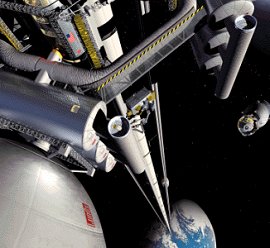The science of nanotechnology could lead to radical improvements for space exploration.
When it comes to taking the next "giant leap" in space exploration, NASA is thinking small - really small.
In laboratories around the country, NASA is supporting the burgeoning science of nanotechnology. The basic idea is to learn to deal with matter at the atomic scale - to be able to control individual atoms and molecules well enough to design molecule-size machines, advanced electronics and "smart" materials.
If visionaries are right, nanotechnology could lead to robots you can hold on your fingertip, self-healing spacesuits, space elevators and other fantastic devices. Some of these things may take 20+ years to fully develop; others are taking shape in the laboratory today.
Thinking small
 Image by artist Pat Rawling. Nanotechnology could provide the very high-strength, low-weight fibers that would be needed to build the cable of a "space elevator." |
Simply making things smaller has its advantages. Imagine, for example, if the Mars rovers Spirit and Opportunity could have been made as small as a beetle, and could scurry over rocks and gravel as a beetle can, sampling minerals and searching for clues to the history of water on Mars. Hundreds or thousands of these diminutive robots could have been sent in the same capsules that carried the two desk-size rovers, enabling scientists to explore much more of the planet's surface - and increasing the odds of stumbling across a fossilized Martian bacterium!
But nanotechnology is about more than just shrinking things. When scientists can deliberately order and structure matter at the molecular level, amazing new properties sometimes emerge.
An excellent example is that darling of the nanotechnology world, the carbon nanotube. Carbon occurs naturally as graphite - the soft, black material often used in pencil leads - and as diamond. The only difference between the two is the arrangement of the carbon atoms. When scientists arrange the same carbon atoms into a "chicken wire" pattern and roll them up into miniscule tubes only 10 atoms across, the resulting "nanotubes" acquire some rather extraordinary traits.
Nanotubes:





No comments:
Post a Comment